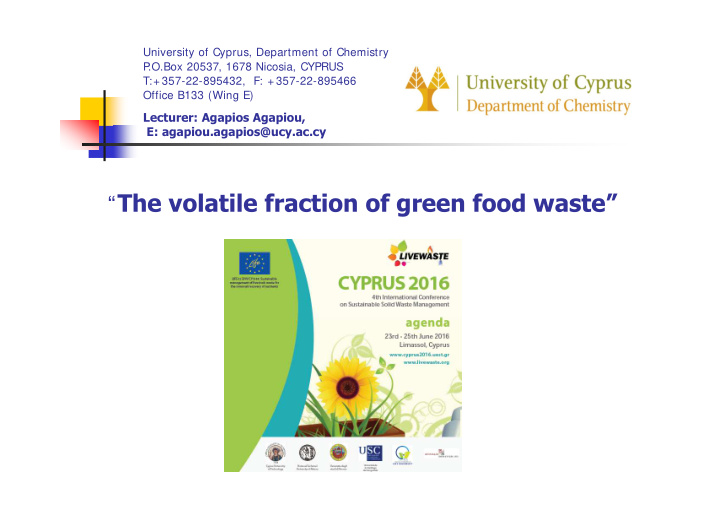



University of Cyprus, Department of Chemistry P .O.Box 20537, 1678 Nicosia, CYPRUS T:+ 357-22-895432, F: + 357-22-895466 Office B133 (Wing E) Lecturer: Agapios Agapiou, E: agapiou.agapios@ucy.ac.cy “ The volatile fraction of green food waste”
OUTLINE 1. Introduction: Gaseous emissions during storing, VOCs importance, Recent trends in recycling/composting process, VOCs detection methods, aeration process. 2. Experimental part 3. Results and discussions 4. Conclusions 5. References
1. INTRODUCTION Storage and compost of food waste emits a complicated mixture of VOCs and inorganic gases (compost emissions account 5% of the global greenhouse budget - high global warming potentials contributing to climate change) VOCs are a large group of anthropogenic or biogenic organic compounds that can be potential air pollutants , due to their malodorous and hazardous properties. VOCs contribute to the formation of ground- level ozone by reacting with NOx ; hundreds of VOCs are emitted from compost and waste facilities/activities Health implications such as nausea, skin sensitization, eye irritation, irritation in the upper respiratory tract and psyco-hygiene effects may potentially be observed
INTRODUCTION The current policy regarding food waste management tends towards recycling for composting usage , initially at house scale and next at composting facilities malodors Possible evolved from household composters may discourage the recycling at house scale The odorous compounds are evolved due to the decomposition of biowaste and plant residues . Microorganisms further enhance the process The most common analytical instruments employed for volatiles detection are: SPME-GC-MS, TD-GC-MS, diffusive samplers, e-noses, olfactometers, combination of them (e.g., olfactometry, GC-MS, gas detector tubes), PTR-TOF-MS Aeration improves the quality of the compost and prevents the anaerobic conditions (S-compounds by gram negative bac teria)
INTRODUCTION - Objective To analyze the household waste emissions of green food waste , when stored in modified waste bins for 15 days, under different aeration conditions few studies volatile According to our knowledge, investigated emissions, except GHGs, during storage of organic waste and even less of storing conditions at home composting , parameters that are of the close interest of waste management operators. This is especially important for countries with limited composting facilities, where separation at source and collection of different waste fractions are promoted.
2. EXPERIMENTAL PART Three experimental scenarios (controlled field experiments) 1. No aeration (“NA,” closed commercial waste bin) 2. Diffusion-based aeration (“DA,” closed commercial waste bin with tiny holes) 3. Enforced aeration (“EA,” closed commercial waste bin with tiny holes and enforced aeration). 36 holes per side (2.5mm diameter) Electric fan specifications 1 hole on the cover (10cm diameter, with Power :220 V / 50 Hz, Consumption: 20W a steel net to protect from insects) Speed: 2300 r.p.m., Air flow: 50 m 3 /h In use for 8h/day (i.e. 2h off – 1h on).
EXPERIMENTAL PART Selected food substrate (freshly, uncooked, mostly green kitchen waste without meat, fish and dairy products) was placed in different layers after being cut into small pieces: Bread: 10 kg Green Vegetables (lettuce, cucumbers): 15 kg Kitchen paper: 2 kg Rice & potatoes: 5 kg Tomatoes: 3 kg Fruits: Oranges, apples, lemons: 15 kg Total waste mass: 50 kg 15 days (early June)
EXPERIMENTAL PART Headspace SPME-GC-MS Portable sensors: GC-MS SPME CO 2 , NH 3 , H 2 S, CH 4 , O 2 HP 5890/5972 GC/MS system Portable Thermometer/Hydrometer K-type thermocouple SPME fiber (85 μ mcarboxen/polydimethylsiloxane on a Stableflex fiber, Supelco)
3. RESULTS AND DISCUSSION The numbered peaks indicate the following VOCs: (1) 2-propanone, (2) acetic acid methyl ester, (3) furan, 2-methyl, (4) acetic acid ethyl ester, (5) disulfide dimethyl, (6) 2- butanone-3-hydroxy, (7) alpha-pinene, (8) sabinene, (9) beta-myrcene, (10) di-limonene, (11) beta-phellandrene, (12) linalool.
RESULTS AND DISCUSSION VOCs with high frequency of appearance in all samples
RESULTS AND DISCUSSION VOCs with high frequency of appearance in the three scenarios
RESULTS AND DISCUSSION Parameters relating to the processes occurring in the modified waste bins
RESULTS AND DISCUSSION The effect of aeration process in the production of VOCs per waste bin
4. CONCLUSIONS 1. The effect of composting aeration on biological decomposition, during the storage of green food waste, was characterized by the emitted VOCs . 2. Three different aeration conditions were tested: without aeration, with aeration (diffusion), and intermittently enforced aeration. Important parameters of short storing and composting bioprocess were additionally monitored for 15 days. 3. The emitted VOCs highly depend on the type of waste in the bin; other factors that affect the process are ambient conditions and decomposition time of fresh food. 4. The release of gaseous emissions from the very early stages was notable. Despite the uniformity of results, the important role of terpenes and, more specifically, that of di-limonene in the released odor was noticed. 5. Aeration process assists the degradation of organic waste fraction. These emissions may be used as indicators of performance in the modified commercial waste bins.
CONCLUSIONS 6. The most frequent VOCs identified over the storing waste, showing over 50 % appearance in all examined samples, were terpenes (e.g., di-limonene, beta- myrcene, delta-3-carene, alpha-pinene, alphaterpinolene,linalool, etc.), sulfides (dimethyl disulfide), aromatics (benzene, 1-methyl-2-(2-propenyl)), alkanes (e.g., decane, dodecane), ketones (2-propanone), esters (e.g., and alcohols (e.g., acetic acidethyl ester, acetic acid methyl ester), 3- cyclohexen-1-ol, 4-methyl-1-(1-methylethyl)). 7. Further studies are needed for optimizing this approach (i.e., pile turning, daily batch-feeling, waste variety, longer period of time, optimum aeration ) and for studying potential social, economic, nutritional, and environmental impacts of green food waste.
5. REFERENCES 1. A. Agapiou, J. P . Vamvakari, A. Andrianopoulos, A. Pappa, Volatile emissions during storing of green food waste under different aeration conditions, Environ. Sci. Pollut. Res. (2016) 23:8890–8901. 2. M. Statheropoulos, A. Agapiou, G. Pallis, A study of volatile organic Atmospheric compounds evolved in urban waste disposal bins, Environment (2005) 39 4639-4645 .
Thank you for your attention!
Recommend
More recommend